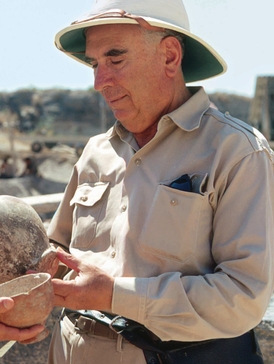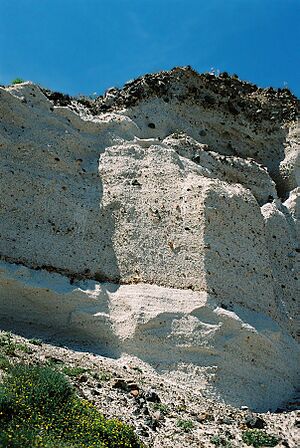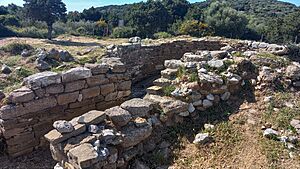Spyridon Marinatos facts for kids
Quick facts for kids
Spyridon Marinatos
|
|
|---|---|
| Σπυρίδων Μαρινάτος | |

Marinatos at Akrotiri in 1968
|
|
| Born |
Spyridon Nikolaou Marinatos
17 November [O.S. 4 November] 1901 Lixouri, Kephallonia, Greece
|
| Died | 1 October 1974 (aged 72) Akrotiri, Santorini, Greece
|
| Resting place | Akrotiri |
| Education |
|
| Known for | Excavations of Akrotiri; theory of the volcanic destruction of Minoan Crete |
| Children | Nanno |
| Honours |
|
| Scientific career | |
| Fields | Archaeology |
| Institutions |
|
| Thesis | Ἤ ἀρχαία θαλασσογραφία (Ancient Marine Art) (1925) |
| Doctoral advisor | Georgios Oikomenos |
| Notable students | Stylianos Alexiou |
| Signature | |
Spyridon Marinatos (Greek: Σπυρίδων Μαρινάτος; November 17, 1901 – October 1, 1974) was a famous Greek archaeologist. He studied ancient Bronze Age cultures like the Minoan civilization and Mycenaean civilization. He is most known for digging up the ancient city of Akrotiri on the island of Santorini. He worked there from 1967 until he died in 1974. Marinatos was seen as one of the most important Greek archaeologists of his time.
Marinatos was born on the island of Kephallonia. He studied at the University of Athens and in Germany. Early in his career, he worked on the island of Crete. There, he excavated many Minoan sites. He also believed that a huge volcanic eruption on Santorini around 1600 BCE caused the end of the Minoan society. In the 1940s and 1950s, he explored and dug in Messenia in southwest Greece. He also found the ancient battlefield of Thermopylae. Marinatos led the Greek Archaeological Service three times. He died while working at Akrotiri in 1974 and is buried there.
Contents
A Life of Discovery
Early Years and Learning
Spyridon Marinatos was born in Lixouri on the Ionian island of Kephallonia on November 17, 1901. His father was a carpenter. Marinatos started studying at the University of Athens in 1916. In 1919, he joined the Greek Archaeological Service. His first job was on Crete as a junior archaeological official. He dug up a Minoan villa at Amnisos and continued to work on the island until 1952.
Marinatos was one of the first students at a special archaeological training school in Athens. He served in the Hellenic Army from 1921 to 1925. In 1925, he earned his doctorate degree. His research was about how marine animals were shown in Minoan art.
In 1926, Marinatos met the British archaeologist Arthur Evans at the Minoan palace of Knossos. Evans had been digging there since 1900. Evans greatly influenced Marinatos's ideas about ancient disasters. Marinatos believed that an earthquake destroyed Knossos. He also dug at other sites on Crete, including Messara, Sklavokampos, and Tylissos.
Marinatos also studied in Germany at the Humboldt University of Berlin and the University of Halle. He became a senior archaeological inspector for eastern Crete in 1929. From 1929 to 1937, he was the director of the Heraklion Museum. During this time, he stopped local goldsmiths from selling fake ancient items. He also found two chamber tombs on his home island of Kephallonia.
Leading Archaeology in Greece
Marinatos became the head of the Greek Archaeological Service from 1937 to 1939. After this, he became a professor at the University of Athens. He was the first to teach about Near Eastern archaeology there.
In 1939, Marinatos went on a lecture tour in the United States. Also in 1939, a Mycenaean palace was found at Pylos. Marinatos helped buy the land for the excavation. He also helped make the site famous as the "Palace of Nestor".
In May 1939, Marinatos found and dug up the battlefield of Thermopylae. This was the site where the Spartans bravely fought the Persian Empire in 480 BCE. His discovery was widely reported and was important for the Greek government at the time.
That same year, Marinatos wrote an article suggesting that the Neopalatial civilization of Crete was destroyed by a huge eruption of the volcano on Thera. He found a lot of volcanic rock at Amnisos that looked like it had been moved by water. This made him think of tsunamis, like those after the Krakatoa eruption in 1883. He wanted to dig on Thera to test his idea, but World War II delayed his plans. Later, in 1950, he thought the story of Atlantis might come from myths about the Thera eruption.
After the war, Marinatos returned to Pylos. He chose to dig in the wider area of Messenia to find new Mycenaean sites. He asked local farmers and hunters where they found ancient items, which helped him discover many unknown sites. He found over twenty archaeological sites in Messenia, including a large building with wall paintings at Iklaina. He worked in Messenia until 1966.
Marinatos briefly led the Archaeological Service again in 1955 but resigned in 1958. He was also the head of the University of Athens from 1958 to 1959.
Akrotiri and Later Years
In 1967, Marinatos was asked to lead the Archaeological Service again by the new military government in Greece. He started a new archaeological journal. He also helped American archaeologists restart their digs in the Athenian agora. He discovered the Mycenaean cemetery of Tsepi near Marathon and dug there from 1969 to 1970.
Marinatos's most famous excavation was at Akrotiri on the island of Thera. People knew about this ancient Minoan settlement since 1867. Marinatos started digging there in 1967. The ancient city was buried under about 150 feet of volcanic rock. He dug tunnels into the site to reach the ruins.
Just five days after starting the excavation on May 24, Marinatos found parts of a Minoan-style building and pottery from Crete. By 1974, he had uncovered an area of about 1 hectare (10,000 square meters). He found amazing wall paintings, which archaeologists called "one of the most important monuments of Aegean art."

Marinatos was removed from his leadership role in January 1974. On October 1, 1974, he died while digging at Akrotiri. He was initially buried at the excavation site. His deputy, Christos Doumas, took over the site and published the first full report of its excavation in 1983.
Views and Impact
Marinatos had strong right-wing and Greek nationalist views. He believed in promoting Greek culture and history. During a time when a military government ruled Greece (1967-1974), Marinatos was reappointed to lead the Archaeological Service. He was seen as a supporter of the government.
Marinatos's leadership was sometimes criticized. Some felt he focused too much on big discoveries rather than careful study. He also made changes that limited the roles of women in Greek archaeology in 1939. However, his daughter, Nanno, said he became disappointed with politics later in his life.
Legacy in Archaeology

Marinatos was a very important figure in Greek archaeology until his death in 1974. Many people, including other archaeologists, considered him one of the greatest Greek archaeologists.
His excavation of Akrotiri is seen as his most important work. It was compared to the famous excavation of Pompeii. Media from all over the world covered his discoveries. Akrotiri is now known as one of the best-preserved ancient settlements. It is especially important for studying Minoan art, like its amazing wall paintings.
Some of Marinatos's ideas were debated. For example, his theory that the Thera eruption destroyed Minoan civilization was not fully accepted at first. Later studies showed that the eruption happened earlier than the end of Minoan society. Today, most scholars believe human reasons caused the end of the Minoan civilization. Also, his idea that the story of Atlantis came from the Thera eruption is generally not accepted by modern scholars.
Despite some criticisms of his leadership style, Marinatos's work had a lasting impact. He discovered many important sites and helped bring Greek archaeology to the world's attention.
Personal Life and Recognition
Marinatos often wore a pith helmet while excavating. He was interested in many subjects like medicine, astronomy, and biology, which helped his archaeological work. He was known for being strong-willed and sometimes strict. However, his students described him as a gifted speaker and a tireless excavator.
Marinatos kept a scrapbook of his appearances in academic and popular newspapers. He worked closely with newspaper editors, giving them interviews and photos. This helped share his discoveries with the public.
Marinatos received many honors. He became a member of the Academy of Athens, Greece's national academy, in 1955. He was also a member of the American Philosophical Society and an honorary member of several archaeological institutes around the world. He received high honors from Greece, France, and Italy.
Marinatos was married twice. His daughter, Nanno Marinatos, also became a scholar of Minoan culture. After his death, a bronze statue of him was placed in the garden of the Archaeological Museum of Chora. A major street in the town is also named after him.
Images for kids
See also
In Spanish: Spyridon Marinatos para niños



